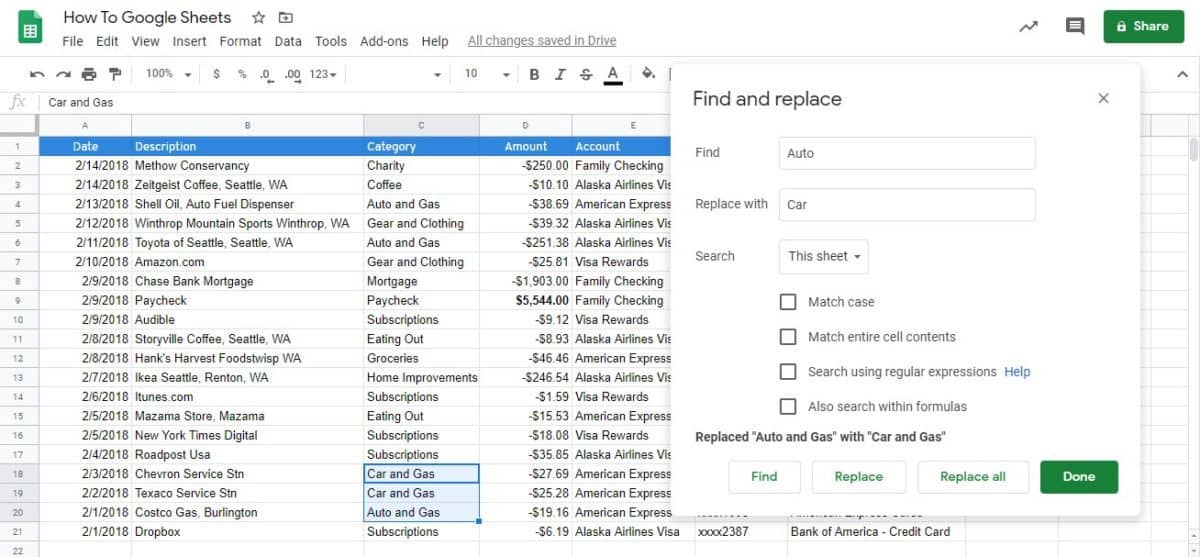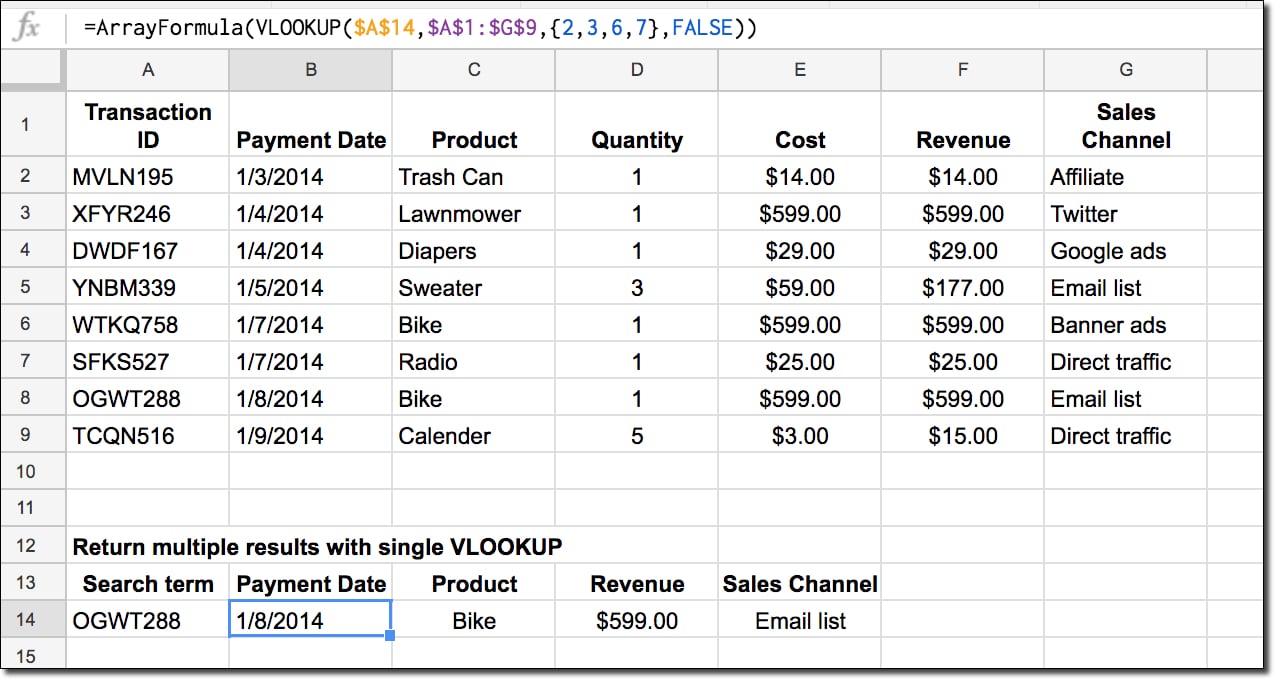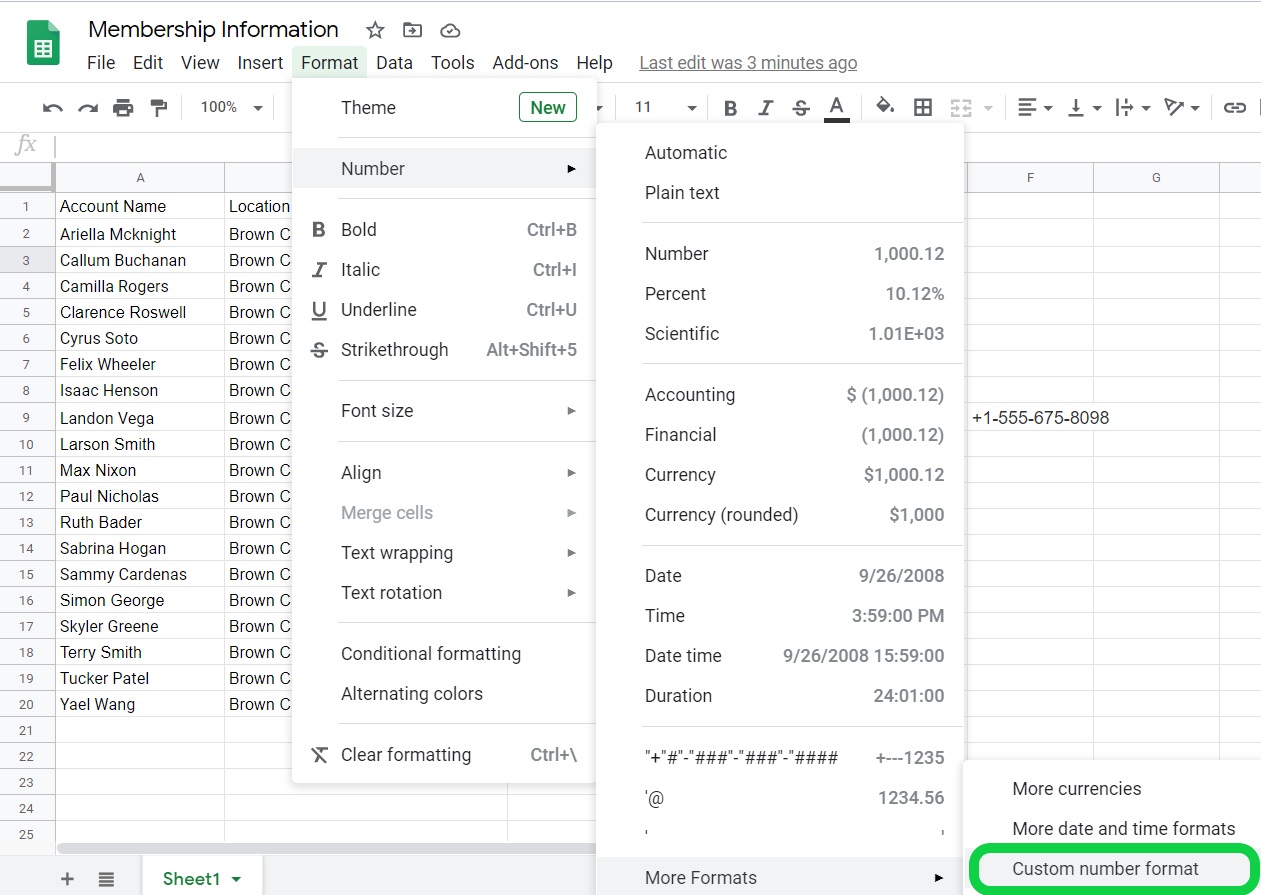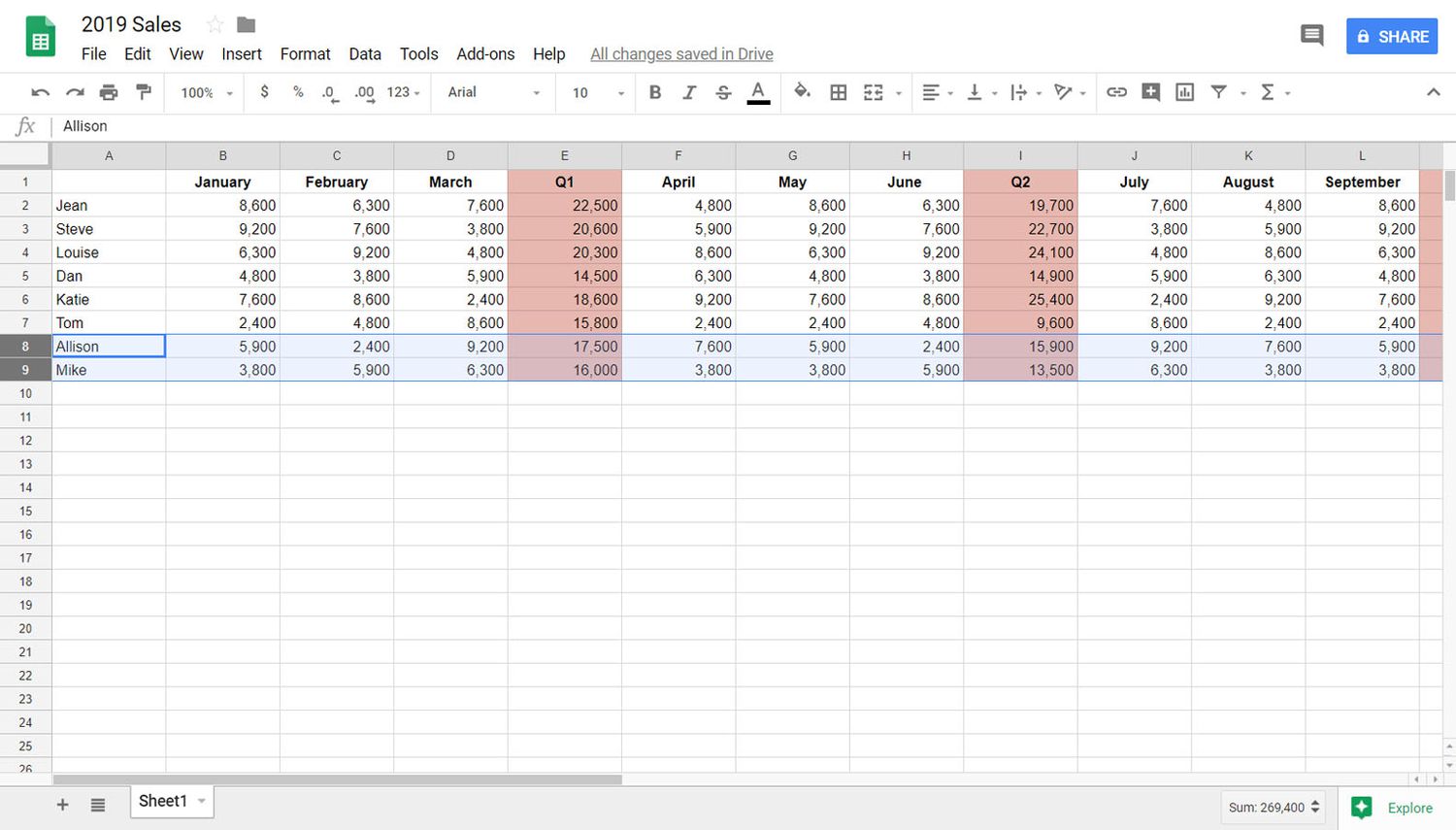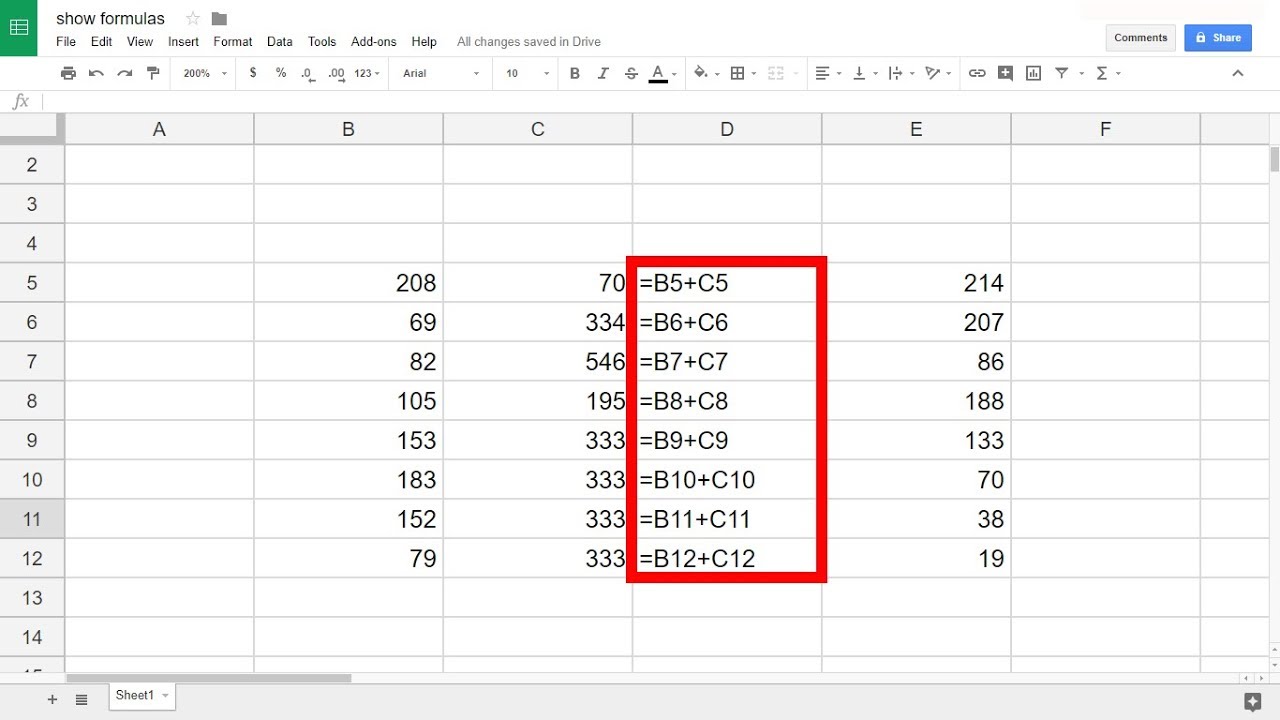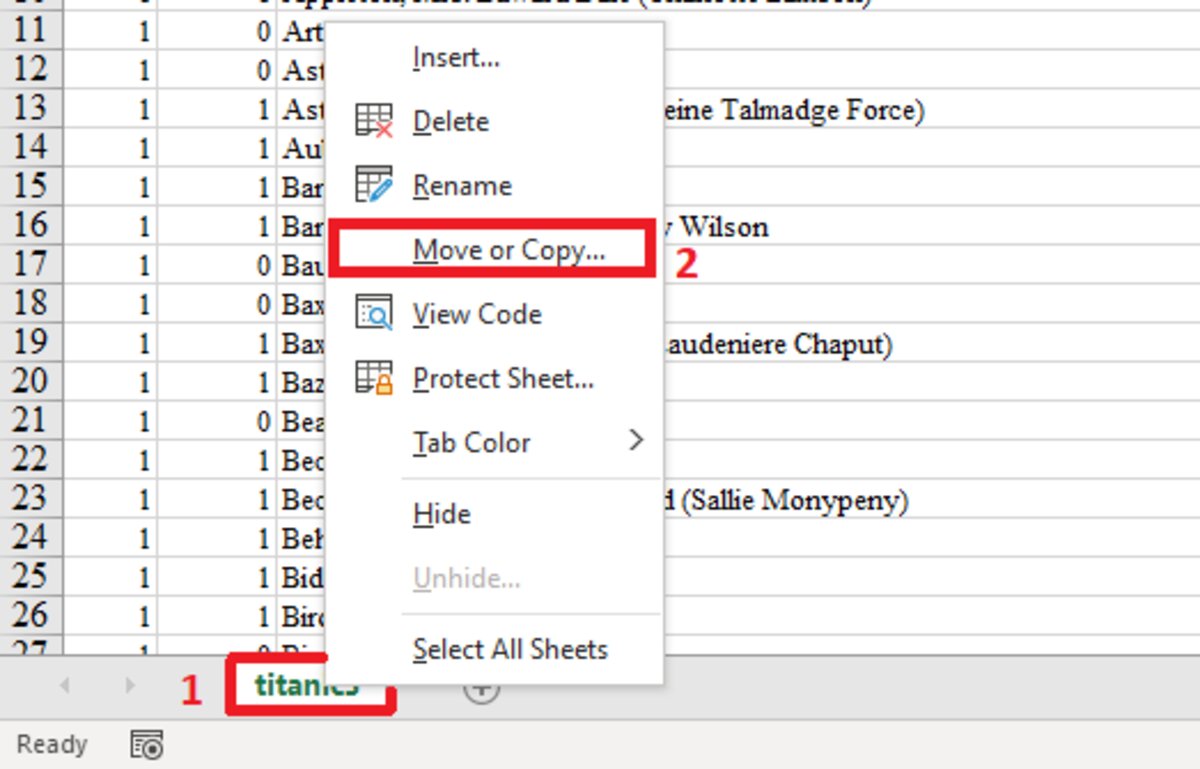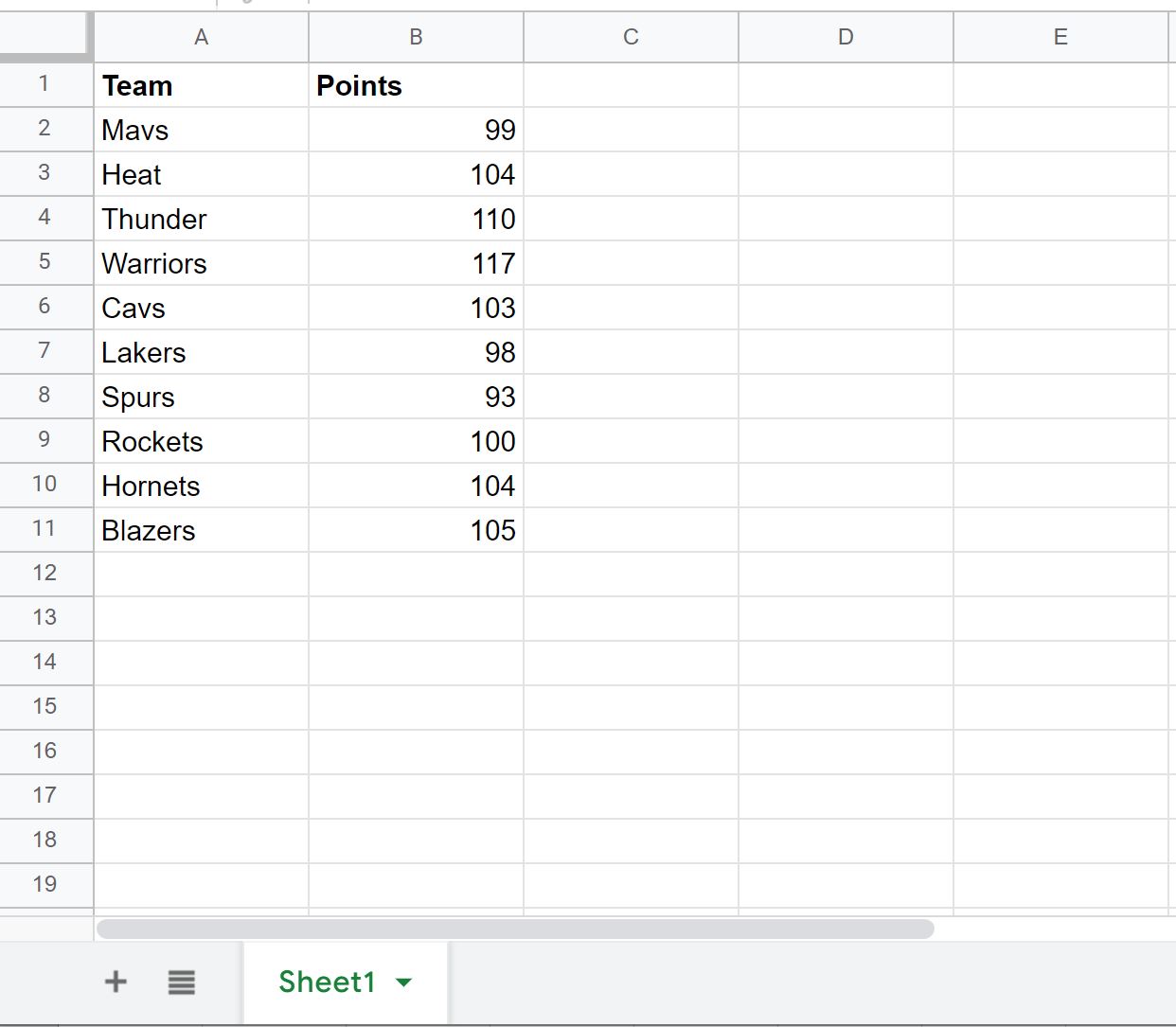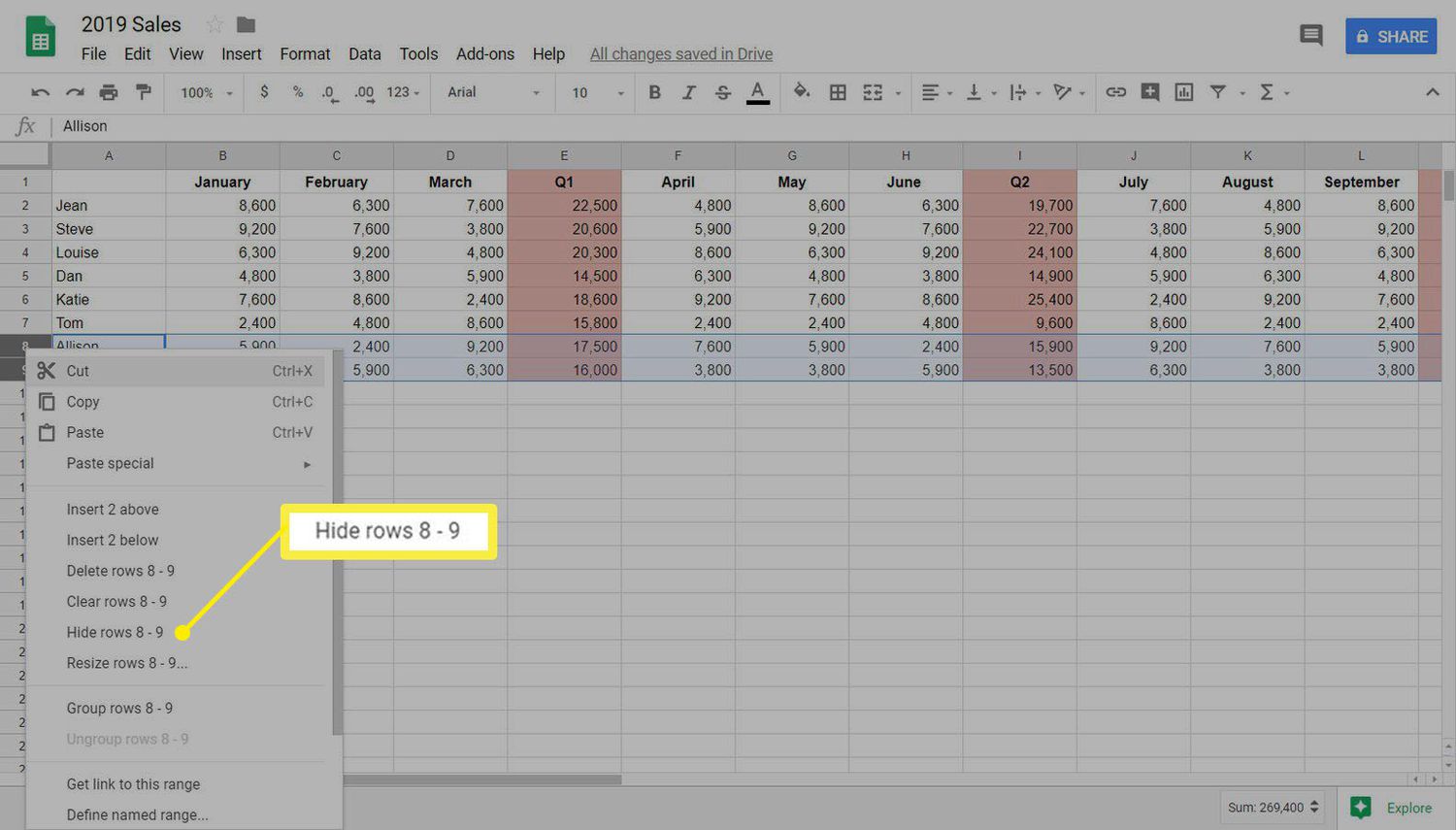Introduction
Google Sheets is a powerful online spreadsheet tool that offers a wide array of features and capabilities. One of the essential functions of any spreadsheet application is the ability to search for specific data within a sheet or across multiple sheets. Whether you’re trying to find a particular value, a specific formula, or a range of cells, understanding how to effectively search on Google Sheets is critical for efficient data management and analysis.
Searching on Google Sheets can save you significant time and effort by quickly locating the information you need without the need for manual scanning or scrolling through large datasets. In this article, we will explore both basic and advanced search techniques that will help you navigate through your spreadsheets with ease.
From using the search bar to searching within a sheet or across multiple sheets, we will cover various methods to retrieve the data you’re looking for. Additionally, we will delve into advanced search techniques, such as using operators, searching by format or functions, and utilizing filters to narrow down your search results.
Along the way, we’ll also provide some tips and tricks to enhance your search experience, including utilizing wildcards, understanding case sensitivity, and creating custom search queries. Moreover, we’ll explore advanced search formulas that you can utilize to perform more complex searches in your Google Sheets.
By the end of this article, you’ll have a comprehensive understanding of the different search techniques available in Google Sheets and how to apply them effectively to streamline your workflow and make the most out of your spreadsheet data.
Basic Search Techniques
When searching for specific data on Google Sheets, you have several basic search techniques at your disposal. These techniques will help you quickly locate and access the information you need within a single sheet or across multiple sheets.
1. Using the Search Bar
The easiest and most common way to search for data is by utilizing the search bar located at the top-right corner of your Google Sheets interface. Simply click on the search bar and enter the keyword or value you’re looking for. Google Sheets will instantly display all instances of that specific keyword or value within the sheet.
Moreover, the search bar also offers suggestions as you type, helping you find relevant data even faster. This feature is particularly useful when you’re unsure of the exact keyword or value you’re searching for.
2. Searching Within a Sheet
If you want to narrow down your search to only one specific sheet in your Google Sheets document, you can utilize the “Find” function. To access this function, press Ctrl + F (Windows) or Command + F (Mac) on your keyboard.
Once the “Find” dialog box appears, enter the keyword or value you want to search for. Google Sheets will highlight the first instance of that keyword or value within the current sheet and provide options to navigate through subsequent occurrences.
3. Searching Across Multiple Sheets
If you’re working with a large spreadsheet document that contains multiple sheets, you might need to search for a specific piece of information across all sheets. Google Sheets allows you to search across multiple sheets by utilizing the “Find” function with a slight modification.
Press Ctrl + Shift + F (Windows) or Command + Option + F (Mac) on your keyboard to open the “Find” dialog box. Enter the keyword or value you’re searching for, and Google Sheets will display all instances of that keyword or value across all sheets in your document.
Using these basic search techniques, you can quickly locate specific data within your Google Sheets and navigate through your spreadsheets with ease. Now let’s explore some advanced search techniques that will further enhance your data searching capabilities on Google Sheets.
Using the Search Bar
One of the most straightforward and effective ways to search for specific data on Google Sheets is by utilizing the search bar. Located at the top-right corner of the interface, the search bar provides a quick and convenient method to find specific information within your spreadsheet.
To use the search bar, simply click on it and enter the keyword or value you’re looking for. As you start typing, Google Sheets will instantly filter and display all instances of that specific keyword or value within the sheet. This real-time filtering makes it easy to identify the relevant data you need.
Furthermore, the search bar offers suggestions and auto-complete functionality, which can be incredibly helpful when you are uncertain about the exact keyword or need assistance with spelling. As you type, Google Sheets will provide suggestions based on the existing data within your sheet.
For example, if you are searching for a specific customer’s name, the search bar will display suggestions of names that match the characters you’ve entered so far. This feature saves you time and effort, as you don’t have to manually type out the entire keyword or value.
Additionally, the search bar allows you to navigate through the search results easily. Once you’ve entered your search query, Google Sheets highlights all occurrences of the keyword or value within the sheet. By clicking on the navigation buttons provided by the search bar, you can cycle through the different instances one by one.
It’s important to note that the search bar is not case-sensitive. This means that whether you type your search query in uppercase or lowercase, Google Sheets will still identify and display the relevant results correctly.
The search bar in Google Sheets is a powerful tool that simplifies the process of finding specific data within a sheet. Whether you’re searching for a particular value, a formula, or a range of cells, utilizing the search bar can help you efficiently locate the information you need, saving you time and effort.
Next, we will explore searching within a sheet using the “Find” function, which allows for more targeted searches in a specific sheet of your Google Sheets document.
Searching Within a Sheet
Searching within a specific sheet in Google Sheets can be easily accomplished using the “Find” function. This function allows you to narrow down your search to a single sheet, making it convenient when you’re working with complex spreadsheets containing numerous data.
To access the “Find” function, simply press Ctrl + F (Windows) or Command + F (Mac) on your keyboard. This action will open the “Find” dialog box at the top-right corner of the Google Sheets interface.
Within the “Find” dialog box, enter the keyword or value you want to search for in the provided text field. Once you’ve entered your search query, Google Sheets will automatically highlight the first instance of that keyword or value within the current sheet.
To navigate through subsequent occurrences of the keyword or value, use the arrow buttons available within the “Find” dialog box. These buttons allow you to jump to the previous or next instance in the sheet, making it easy to review and analyze the relevant data.
Furthermore, the “Find” function in Google Sheets offers additional options to refine your search. For example, you can choose to search within formulas only by selecting the “Search using regular expressions” option within the “Find” dialog box.
This feature is particularly useful when you want to locate cells that contain specific formulas or functions. By selecting this option, Google Sheets will only highlight cells where your search query appears within a formula, ignoring other types of values or text.
It’s important to note that the “Find” function is case-insensitive, meaning it will identify and display both uppercase and lowercase matches. This ensures that you don’t miss any relevant data due to variations in capitalization.
Searching within a sheet using the “Find” function in Google Sheets allows you to efficiently locate specific data without the need to manually scan through the entire sheet. By utilizing the search capabilities, you can save time and focus your attention directly on the relevant information you’re looking for.
In the next section, we will explore searching across multiple sheets, which can be particularly helpful when working with large spreadsheet documents that contain multiple sheets of data.
Searching Across Multiple Sheets
Google Sheets offers the ability to search for specific data across multiple sheets within a single spreadsheet document. This feature is especially useful when working with larger datasets that span multiple sheets or tabs.
To search across multiple sheets in Google Sheets, you can utilize the “Find” function with a slight modification. Instead of using the regular shortcut (Ctrl + F or Command + F) to open the “Find” dialog box, you need to use the keyboard shortcut Ctrl + Shift + F (Windows) or Command + Option + F (Mac).
Once you’ve opened the “Find” dialog box with the modified shortcut, enter the keyword or value you want to search for in the provided text field. Google Sheets will search for that specific keyword or value across all sheets in the current spreadsheet document.
The search results will be displayed as a list on the right side of the “Find” dialog box. Each entry in the list represents an instance where the keyword or value was found, along with the name of the sheet and the cell reference.
By clicking on any entry in the search results list, Google Sheets will navigate to the respective sheet and highlight the corresponding cell where the keyword or value appears. This allows for a seamless transition between sheets and makes it easy to locate the desired information quickly.
It’s important to note that when searching across multiple sheets, the “Find” function only considers the visible sheets within the spreadsheet document. If there are hidden or filtered sheets, Google Sheets will exclude them from the search operation.
Furthermore, the search function in Google Sheets is case-insensitive when searching across multiple sheets. This means that it will identify and display matches regardless of the capitalization of the keyword or value. This flexibility ensures that you can find the information you need, even if there are variations in capitalization.
Searching across multiple sheets in Google Sheets is a powerful feature that allows you to locate specific data efficiently, even in complex spreadsheet documents. By utilizing this capability, you can easily navigate through different sheets and access the relevant information you’re searching for.
In the next section, we will explore advanced search techniques, including the use of operators, searching by format or functions, and utilizing filters to further refine your search results.
Advanced Search Techniques
While basic search techniques in Google Sheets provide a convenient way to locate specific data, advanced search techniques offer more granular control and flexibility. These techniques allow you to perform complex searches, filter data based on specific criteria, and search by format or functions. Let’s explore some of these advanced search techniques.
1. Using Operators
Google Sheets supports various operators that can be used in search queries to refine and narrow down your search results. Some commonly used operators include:
- AND: Use the operator “AND” between two or more keywords to find data that includes all of those keywords. For example, searching for “apple AND banana” will return results that contain both “apple” and “banana”.
- OR: Use the operator “OR” between two or more keywords to find data that includes any of those keywords. For example, searching for “apple OR banana” will return results that contain either “apple” or “banana”.
- NOT: Use the operator “NOT” before a keyword to exclude that keyword from the search results. For example, searching for “apple NOT banana” will return results that contain “apple” but not “banana”.
2. Searching by Format
Google Sheets allows you to search for data based on specific cell formatting, such as font color, background color, or text formatting. To search by format, open the “Find” dialog box and click on the “Format” button. From there, you can choose the formatting criteria you want to search for.
For example, you can search for cells with a specific font color or cells that have conditional formatting rules applied to them. This feature is particularly useful when you’re trying to locate specific data based on visual cues or formatting patterns.
3. Searching by Functions
If you’re working with formula-driven spreadsheets, you can search for data by specific functions or formulas used in cells. By using the “Search using regular expressions” option within the “Find” dialog box, you can narrow down your search to only cells that contain specific functions or formulas.
For example, you can search for cells that use the SUM function or cells that contain a specific custom formula. This allows you to quickly identify and analyze cells that perform specific calculations or refer to specific data ranges.
4. Searching with Filters
Google Sheets offers powerful filtering capabilities that allow you to search for data based on specific criteria. By applying filters to your spreadsheet, you can display only the data that meets certain conditions.
To apply filters, select the range of data you want to filter and click on the “Data” menu. From there, choose the “Filter” option. This will enable filter buttons for each column in the selected range, allowing you to set specific filtering conditions.
By combining multiple filter conditions, you can create complex search queries to find the exact data you’re looking for. This is particularly useful when working with large datasets that require precise filtering to isolate specific data subsets.
By utilizing these advanced search techniques, you can perform more targeted and complex searches in Google Sheets. Whether you need to search by specific operators, formatting, functions, or apply filters, these techniques provide a powerful way to retrieve the exact data you’re looking for.
In the next section, we will explore some useful tips and tricks that will further enhance your search experience in Google Sheets.
Using Operators
When conducting advanced searches in Google Sheets, using operators can significantly enhance your search capabilities. Operators allow you to refine and narrow down your search results by combining keywords or excluding specific terms. Let’s explore some commonly used operators in Google Sheets.
- AND: The “AND” operator is used to find data that includes all of the specified keywords. When you use the “AND” operator, Google Sheets will return results that contain both keywords. For example, searching for “apple AND banana” will display cells or instances that contain both “apple” and “banana”.
- OR: The “OR” operator allows you to search for data that includes any of the specified keywords. When you use the “OR” operator, Google Sheets will return results that contain either one keyword or the other. For example, searching for “apple OR banana” will show cells or instances that contain either “apple” or “banana”.
- NOT: The “NOT” operator allows you to exclude specific terms or keywords from your search. When you use the “NOT” operator, Google Sheets will return results that do not include the specified term. For example, searching for “apple NOT banana” will display cells or instances that contain “apple” but do not contain “banana”.
Combining these operators can help you create more complex and targeted search queries. For instance, you can use parentheses to group terms and create nested searches. This allows you to refine your search further and obtain specific data that matches your criteria.
It’s important to note that operators are not case-sensitive in Google Sheets searches. This means that whether you use uppercase or lowercase letters, the search function will still identify and display the results accordingly.
Using operators in Google Sheets is a powerful way to refine and narrow down your search results. By combining keywords with operators like AND, OR, and NOT, you can retrieve more specific data and focus on the information that is most relevant to your needs.
In the next section, we will explore another advanced search technique, searching by format, which allows you to find data based on specific cell formatting criteria.
Searching by Format
Searching by format in Google Sheets allows you to find specific data based on the formatting attributes applied to cells. This advanced search technique is particularly useful when you want to locate data that shares common formatting criteria, such as font color, background color, or text formatting.
To search by format, open the “Find” dialog box by pressing Ctrl + F (Windows) or Command + F (Mac) on your keyboard. Within the dialog box, click on the “Format” button located at the bottom-left corner. This will open a dropdown menu where you can select the format criteria you wish to search for.
Google Sheets provides a range of format criteria to choose from, including font color, background color, bold text, italic text, strikethrough, and many more. By selecting one or multiple format criteria, you can refine your search to cells that meet the specified formatting attributes.
For example, if you want to find all cells with a font color of red, choose the “Font color” option from the dropdown menu and select the color red. This will display all cells that have red font color, making it easy to identify and analyze the corresponding data.
Additionally, you can search for cells with specific formatting patterns or styles, such as cells with conditional formatting rules applied to them. By selecting the respective format option, Google Sheets will highlight the cells that meet the specified formatting criteria.
It’s important to note that searching by format in Google Sheets does not alter the underlying data or change the formatting settings. It only helps you identify cells that match the specified formatting criteria, allowing you to focus on the relevant information in your spreadsheet.
By utilizing the search by format feature in Google Sheets, you can quickly locate cells with specific formatting attributes, making it easier to analyze and work with your data. Whether you’re looking for cells with a certain font color, background color, or other formatting attributes, this technique ensures that you can pinpoint the data you need effectively.
In the next section, we will explore another advanced search technique, searching by functions, which allows you to find cells based on the functions or formulas used within them.
Searching by Functions
Searching by functions in Google Sheets enables you to locate specific data based on the functions or formulas used within cells. This advanced search technique is particularly useful when working with formula-driven spreadsheets and allows you to quickly find cells that perform specific calculations or refer to specific data ranges.
To search by functions, open the “Find” dialog box by pressing Ctrl + F (Windows) or Command + F (Mac) on your keyboard. Within the dialog box, click on the “Search using regular expressions” option located at the bottom-left corner.
Once the regular expression option is enabled, you can enter the specific function or formula you’re searching for in the provided text field. Google Sheets will search within the cells and highlight instances where the function or formula matches the search query.
For example, if you want to find cells that use the SUM function, enter “SUM” in the search field. This will display all cells that contain the SUM function, allowing you to easily locate and analyze the calculations performed using that function.
Similarly, you can search for cells containing custom formulas by inputting the specific formula in the search field. This helps you identify cells that use specific calculations or logic, making it easier to analyze and understand the data and formulas used in your spreadsheet.
Searching by functions is not case-sensitive, meaning that the search results will not be affected by the capitalization of the function or formula. Whether you use uppercase or lowercase letters, Google Sheets will identify and display the relevant cells that match the search query.
Utilizing the search by functions feature in Google Sheets allows you to quickly find cells that utilize specific functions or formulas. By pinpointing these cells, you can focus on the calculations and formulas that are crucial to your analysis, making data analysis and troubleshooting more efficient.
In the next section, we will explore another advanced search technique, searching with filters, which enables you to narrow down your search based on specific conditions and criteria.
Searching with Filters
Searching with filters in Google Sheets allows you to narrow down your search results based on specific conditions and criteria. This powerful feature enables you to focus on specific subsets of data that meet certain requirements, making it easier to analyze and work with large datasets.
To apply filters in Google Sheets, select the range of data you want to filter by clicking and dragging over the desired cells. Then, go to the “Data” menu and select the “Filter” option. This will add filter buttons to the headers of each column within the selected range.
Once the filters are applied, you can click on the filter button in any column to open the filter menu. From there, you can define specific conditions and criteria to filter the data. For example, you can filter by text, numbers, dates, or even create custom formulas to filter the data.
Using filters, you can search for data that meets specific criteria within a column. For instance, you can filter a column to display only entries that contain a certain keyword, or for numeric columns, you can filter for values that are greater than or equal to a specific number.
Alternatively, you can also apply multiple filters across different columns to create more complex search queries. This allows you to combine conditions and criteria from different columns to narrow down your search even further.
By utilizing filters, you can dynamically view and analyze the data that matches your specified criteria. Filters can be modified or removed at any time, giving you the flexibility to adjust your search as needed.
It’s important to note that applying filters does not modify the underlying data in your spreadsheet. Filters are temporary views that allow you to focus on specific subsets of data without permanently changing the original data.
Searching with filters in Google Sheets is a powerful way to refine and narrow down your search results based on specific conditions and criteria. By applying filters to your data, you can efficiently analyze and work with subsets of data that meet your specified requirements.
In the next section, we will explore some useful tips and tricks to further enhance your search experience in Google Sheets.
Tips and Tricks
When it comes to searching in Google Sheets, there are several tips and tricks you can employ to enhance your search experience and efficiency. These tips will help you make the most out of the search capabilities and streamline your workflow. Let’s explore some useful tips and tricks:
1. Using Wildcards in Search
Utilizing wildcards can be extremely helpful when you’re unsure of the exact keyword you’re searching for or when you need to search for multiple variations of a term. Google Sheets supports two main wildcard characters:
- Asterisk (*): Use the asterisk as a placeholder for any number of characters. For example, searching for “app*” will match instances of “apple”, “application”, and “approve”.
- Question Mark (?): Use the question mark as a placeholder for a single character. For example, searching for “s?un” will match instances of “sun” and “spin” but not “star” or “spoon”.
By incorporating wildcards into your search queries, you can broaden the scope of your search and locate data more effectively.
2. Case-Sensitive vs. Case-Insensitive Search
By default, the search in Google Sheets is case-insensitive. This means that uppercase and lowercase letters are treated as the same when searching for data. However, you can perform a case-sensitive search by selecting the “Case sensitive” option within the “Find” dialog box.
Case-sensitive searching allows you to differentiate between uppercase and lowercase letters, providing more precise search results when needed.
3. Creating Custom Search Queries
Google Sheets allows you to create custom search queries by combining various search techniques and operators. By using operators like AND, OR, and NOT, along with specific keywords or values, you can create complex search queries that meet your specific requirements.
Experimenting with custom search queries can help you refine your searches and retrieve more targeted results, saving you time and effort in locating the desired data.
4. Advanced Search Formulas
If you’re familiar with spreadsheet functions and formulas, you can leverage advanced search formulas to perform even more complex searches in Google Sheets. By combining functions like FILTER, QUERY, or LOOKUP with specific criteria, you can create dynamic search formulas that retrieve specific data based on your needs.
These advanced search formulas allow you to automate and streamline your search processes, making it easier to extract and analyze relevant information from your spreadsheets.
By implementing these tips and tricks, you can optimize your search capabilities in Google Sheets and improve your productivity when locating specific data. Experiment with different techniques and explore the possibilities to find what works best for your unique requirements.
Now that you’re armed with these tips and tricks, you can take your Google Sheets search skills to the next level and save valuable time in navigating and analyzing your spreadsheet data.
Using Wildcards in Search
When searching in Google Sheets, utilizing wildcards can be a powerful technique to broaden your search parameters and locate specific data more effectively. Wildcards act as placeholders for unknown or varying characters, allowing you to search for multiple variations of a term or include different variations within a single search query.
Google Sheets supports two main wildcard characters that you can use in your search queries:
- Asterisk (*): The asterisk is used as a placeholder for any number of characters. For example, searching for “app*” will match instances of “apple”, “application”, “approve”, and any other word that starts with “app”. This wildcard is especially useful when you are uncertain of the exact keyword or when you want to search for multiple variations of a term.
- Question Mark (?): The question mark is used as a placeholder for a single character. For example, searching for “s?un” will match instances of “sun” and “spin” but not “star” or “spoon”. The question mark wildcard is helpful for finding words with similar spelling but with a varying letter or for narrowing down search results.
By incorporating wildcards into your search queries, you can expand the scope of your search and locate data more effectively. These wildcards allow for more flexibility and adaptability when searching for specific information within your Google Sheets.
It’s important to note that wildcards can be used in combination with other keywords or operators to create more advanced search queries. For example, you can combine a search term with an asterisk wildcard to find all instances that contain a particular sequence of characters. Likewise, you can use wildcards in combination with logical operators like AND or NOT to refine and customize your search results.
When using wildcards, keep in mind that Google Sheets search is not case-sensitive by default. This means that uppercase and lowercase letters are considered the same. However, you can enable case-sensitive search by selecting the “Case sensitive” option within the “Find” dialog box.
By mastering the art of using wildcards in your Google Sheets searches, you can quickly locate the data you need, even when the specific keywords or values may vary in their spelling or format. Incorporate wildcards into your search queries to enhance your search capabilities and save time in finding the desired information within your spreadsheets.
In the next section, we will explore the concept of case sensitivity in Google Sheets searches and its impact on your search results.
Case-Sensitive vs. Case-Insensitive Search
In Google Sheets, you have the capability to perform both case-sensitive and case-insensitive searches. Understanding the difference between these two search modes can help you retrieve more accurate and relevant search results.
By default, Google Sheets search is set to be case-insensitive. This means that the search function treats uppercase and lowercase letters as the same. For example, a search for “apple” will return results for “apple”, “Apple”, and “APPLE”. This is helpful when you want to find data regardless of the capitalization used.
However, there are situations where you may need to perform a case-sensitive search. Enabling case-sensitive search means that the search function will distinguish between uppercase and lowercase letters, providing more precise search results. This is particularly useful when you need to find specific instances that match the exact case of your search query.
To perform a case-sensitive search in Google Sheets, you can select the “Case sensitive” option within the “Find” dialog box. This option ensures that the search results will only include instances that match the case of your search query exactly.
When you enable case-sensitive search, it’s important to note that the search function will only consider the exact case, and any variation in capitalization will not be included in the search results. Therefore, it’s crucial to double-check the correct case when performing a case-sensitive search.
Understanding the distinction between case-sensitive and case-insensitive search can greatly impact the accuracy and relevance of your search results. Depending on the nature of your search and the specific data you’re looking for, choosing the appropriate case sensitivity mode can help you locate the desired information more efficiently.
In the next section, we will explore the concept of creating custom search queries, which allows you to combine different search techniques and operators to tailor your search results to specific requirements.
Creating Custom Search Queries
In Google Sheets, you have the capability to create custom search queries by combining different search techniques and operators. This allows you to tailor your search results to meet specific requirements and retrieve the exact information you’re looking for.
Custom search queries can be created by combining keywords, wildcards, operators, and other search parameters. Here are some techniques and tips to help you create effective custom search queries:
Utilize Operators: Operators like AND, OR, and NOT can be used to refine and narrow down your search results. By using these operators, you can combine multiple keywords or conditions to create more targeted queries. For example, searching for “apple AND banana” will only display results that contain both the words “apple” and “banana”.
Incorporate Wildcards: Wildcards, such as the asterisk (*) or question mark (?), can be used as placeholders to match unknown or varying characters within your search query. This is helpful when you need to search for variations or patterns of a specific term. For example, searching for “app*” will match results that include “apple”, “application”, and “approve”.
Use Parentheses for Grouping: Parentheses can be used to create nested search queries and control the order of operations. By grouping keywords and conditions within parentheses, you can ensure that certain parts of your query are evaluated together. This is particularly useful when combining multiple operators within a single search query.
Combine Multiple Search Techniques: You can combine different search techniques, such as searching by format, functions, or filters, to create more complex custom search queries. For example, you can search for cells that contain a specific function (using “Search using regular expressions”) and have a specific font color (using the format search). This allows you to refine your search even further and retrieve more specific results.
By experimenting with different combinations of keywords, operators, wildcards, and search techniques, you can create custom search queries that meet your specific needs. This flexibility allows you to fine-tune your searches and retrieve the most relevant and accurate information from your Google Sheets.
Remember to adjust your search queries based on the nature of your data and the specific requirements of your analysis. Custom search queries give you the power to tailor your searches and extract precisely the information you need from your spreadsheets.
In the next section, we will explore advanced search formulas, which offer even more robust capabilities for searching and analyzing data in Google Sheets.
Advanced Search Formulas
Google Sheets provides powerful features and functions that allow for advanced search capabilities through the use of formulas. These formulas enable you to perform complex searches and retrieve specific data based on various criteria. By leveraging advanced search formulas, you can automate the search process and streamline your data analysis.
Here are a few advanced search formulas in Google Sheets:
FILTER: The FILTER function allows you to extract specific rows or columns from a range of data based on specified conditions. By using logical expressions or formulas as conditions, you can create dynamic search queries that retrieve the data that meets your specified criteria.
QUERY: The QUERY function provides a powerful way to search and retrieve data using SQL-like syntax. With QUERY, you can perform complex searches combining multiple conditions and criteria. This formula allows you to specify the columns, filter rows, sort data, and perform calculations all within a single formula.
LOOKUP: The LOOKUP function allows you to search for a specific value in a range and return a related value from another column in the same row. This can be useful when you have a key or identifier and want to retrieve additional information associated with that key.
INDEX & MATCH: By combining the INDEX and MATCH functions, you can perform advanced searches to retrieve specific values from a range based on multiple criteria. INDEX returns the value at a given position in a range, while MATCH searches for a specified value in a range and returns its relative position. Together, they provide a powerful tool for locating specific data in your spreadsheet.
These advanced search formulas allow you to automate and customize your search queries, making it easier to retrieve specific data based on complex conditions and criteria. You can even combine multiple advanced search formulas to create more advanced and robust search operations within your Google Sheets.
It’s important to familiarize yourself with the syntax and usage of these advanced search formulas to effectively use and customize them for your specific needs. The Google Sheets documentation and online resources provide detailed information on each formula and its various applications.
By mastering the use of advanced search formulas, you can take your data analysis in Google Sheets to the next level, gaining more control and efficiency in retrieving the information that is crucial for your decision-making and analysis processes.
In the next section, we will conclude our exploration of search techniques in Google Sheets and summarize the key takeaways.
Conclusion
Google Sheets offers a range of powerful search techniques and capabilities that allow you to efficiently locate and retrieve specific data within your spreadsheets. By mastering these search techniques, you can streamline your workflow, save time, and make the most out of your spreadsheet data.
In this article, we explored various search techniques, both basic and advanced. We learned how to use the search bar to find data within a sheet and search across multiple sheets. Additionally, we delved into advanced techniques such as using operators to refine search queries, searching by format or functions, and utilizing filters to narrow down search results.
We also discussed some tips and tricks to enhance your search experience, including using wildcards to search for variations of a keyword, understanding case sensitivity, creating custom search queries, and leveraging advanced search formulas to automate complex searches.
It’s important to understand that the effectiveness of your searches relies on clear and specific search queries. By combining different search techniques and operators, you can tailor your searches to retrieve the precise data you need.
Take the time to experiment and familiarize yourself with the different search capabilities offered by Google Sheets. By utilizing the search bar, advanced search techniques, and custom search queries, you can navigate through your spreadsheets seamlessly and locate the information you need with ease.
Remember, efficient searching is just one aspect of effective spreadsheet management. Continuously improving your skills and exploring new features will help you become more proficient in working with Google Sheets and analyzing your data.
So, whether you’re a beginner or an experienced user, the search techniques discussed in this article will enable you to efficiently find and analyze the data within your Google Sheets, enhancing your productivity and unlocking the full potential of your spreadsheets.







